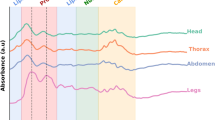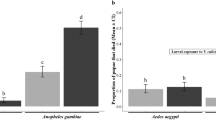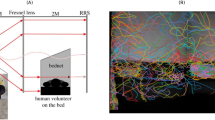Abstract
THE flight activity of female Anopheles gambiae Giles, recorded in the laboratory, follows a bimodal cycle1. In LD12:12 (alternating 12 h light:12 h dark) the first peak comes shortly after light-off and there is a secondary phase of activity which reaches its maximum in the middle or latter part of the dark phase. This secondary activity occurs at the time when host seeking and biting take place in the wild2; the initial peak corresponds with the time of egress of mosquitoes from their daytime resting places and, in particular, in virgin females, with the time of mating3. In normal conditions, A. gambiae females are inseminated only once in their lifetime4,5, and usually not before they are 2–3 d old (ref. 3). We show here that, after insemination, the first peak of activity is greatly reduced and the secondary phase of activity is enhanced. This switch in activity is likely to represent a change from mating to host seeking behaviour.
This is a preview of subscription content, access via your institution
Access options
Subscribe to this journal
Receive 51 print issues and online access
$199.00 per year
only $3.90 per issue
Buy this article
- Purchase on SpringerLink
- Instant access to full article PDF
Prices may be subject to local taxes which are calculated during checkout
Similar content being viewed by others
References
Jones, M. D. R., Cubbin, C. M. & Marsh, D. J. exp. Biol. s7, 347–357 (1972).
Gillies, M. T. & DeMeillon, B. The Anophelinae of Africa South of the Sahara Pub. S. Afr. Inst. med. Res. 54, (1968).
Charlwood, J. D. thesis, Univ. Sussex (1976).
Goma, L. K. H. Nature 197, 99–100 (1968).
Bryan, J. H. Nature 218, 489 (1968).
Jones, M. D. R., Hill, M. & Hope, A. M. J. exp. Biol. 47, 503–511 (1967).
Craig, G. B., Jr. Science 156, 1499–1501 (1967).
Gwadz, R. W., Craig, G. B., Jr. & Hickey, W. A. Biol. Bull. 140, 201–214 (1971).
Ramalingham, S. & Craig, G. B., Jr Canada Entomol. 108, 955–960 (1976).
Downe, A. E. R. J. Insect. Physiol. 21, 1835–1839 (1971).
Author information
Authors and Affiliations
Rights and permissions
About this article
Cite this article
JONES, M., GUBBINS, S. Modification of circadian flight activity in the mosquito Anopheles gambiae after insemination. Nature 268, 731–732 (1977). https://doi.org/10.1038/268731a0
Received:
Accepted:
Issue date:
DOI: https://doi.org/10.1038/268731a0
This article is cited by
-
Evaluation of insemination, blood feeding, and Plasmodium vivax infection effects on locomotor activity patterns of the malaria vector Anopheles darlingi (Diptera: Culicidae)
Parasitology Research (2024)
-
Adenosine triphosphate overrides the aversive effect of antifeedants and toxicants: a model alternative phagostimulant for sugar-based vector control tools
Parasites & Vectors (2023)
-
Effects of insemination and blood-feeding on locomotor activity of wild-derived females of the malaria mosquito Anopheles coluzzii
Parasites & Vectors (2021)
-
Video Recording Can Conveniently Assay Mosquito Locomotor Activity
Scientific Reports (2020)
-
What does not kill it makes it weaker: effects of sub-lethal concentrations of ivermectin on the locomotor activity of Anopheles aquasalis
Parasites & Vectors (2017)



